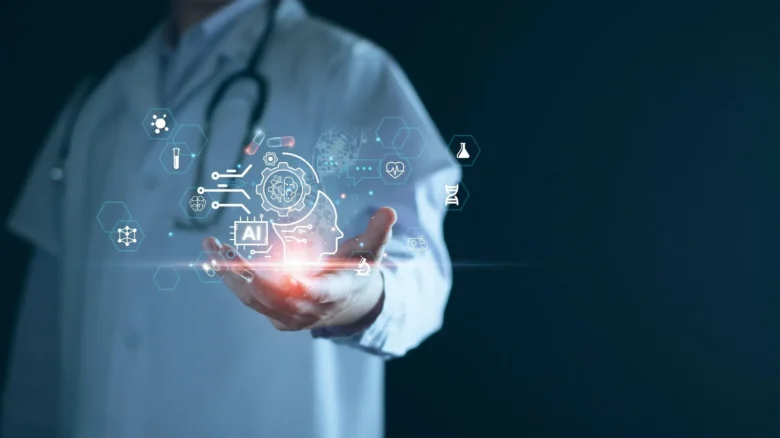Healthcare can present numerous obstacles; however, innovative tools and technologies exist that help save lives. Survey respondents highlighted electronic health records (EHRs) and tools for professional-to-professional communication as top technologies that save staff time; other novel technologies ranked lower.
1. AI-Driven Diagnostics
AI technologies are revolutionizing medical diagnosis, providing early detection and personalized treatment plans. Leveraging machine learning algorithms, AI systems can quickly analyze large amounts of data with remarkable accuracy to detect complex patterns with pinpoint precision.
AI systems have proven their worth in medical imaging by quickly and accurately detecting abnormal findings on X-rays and CT scans more quickly and efficiently than humans can, saving costs through reduced test volumes while improving patient outcomes through prompt intervention. Integrating artificial intelligence (AI) tools into healthcare requires robust security measures. Implementing end-to-end encryption, access controls, and data anonymization techniques will help to comply with data protection regulations while safeguarding patients’ privacy.
2. Comprehensive Electronic Health Records
EHRs digitize patient information and automate much of the documentation performed with pen-and-paper, thus saving time spent reading indecipherable handwriting and speeding billing processes. They also streamline billing procedures and enhance communication between doctors and patients through messaging platforms to increase operational efficiency and operational effectiveness.
Strict access protocols protect patient data from hackers and thieves while providing a more comprehensive view of disease trends through aggregated patient data collection and analysis. Research-oriented EHRs depend on consistent structures for their data in order to facilitate epidemiological and pragmatic clinical trials.
These systems are especially beneficial during public health crises like the COVID-19 pandemic by highlighting social determinants of health (SDOH) and disparate disease outcomes across populations [214]. Such data provides invaluable insight for more holistic healthcare delivery and medical research approaches.
3. 3D Printing
3D printing technology has long been utilized within medical settings to produce highly realistic surgical training models that enable surgeons to rehearse and perfect their surgeries with pinpoint precision. These models allow surgeons to hone their craft while practicing every maneuver for smooth and successful procedures.
This technology can also be used to design customized prosthetics and implants. For instance, patients suffering from aneurysms could receive a personalized stent to reduce blood flow to their brain. 3D printing technology is also being utilized to produce forceps, clamps, and hemostats tailored specifically for each surgery using 3D-generated anatomical models as surgical guides, cutting surgery times by an impressive 62%. A recent study in 2021 demonstrated this trend.
4. Telemedicine
Healthcare systems have taken advantage of telemedicine technology and can now offer video or phone appointments with physicians, nurses, and physical and occupational therapists—helping prevent overcrowded emergency rooms while giving those with limited mobility an easier way to schedule an appointment close to home.
Telemedicine has been defined in numerous ways. This report seeks to create a simple definition combining three elements—information and telecommunications technologies, distance between participants, and health or medical applications—into one concise statement. Furthermore, an evaluation framework will also be created that incorporates many existing criteria used for clinical practice, research, and technology assessment.
5. Internal Communication Platforms
Internal communication tools are digital platforms designed to serve as a central repository of company updates, instant messaging, video conferencing, file sharing, and file storage. They facilitate collaboration among teams while increasing transparency—increasing alignment, productivity, and employee engagement in the process. Effective communication is often at the root of workplace failures when working with distributed teams, especially when those teams rely on individual emails for critical updates and response times are slow; additionally, switching apps wears employees down quickly.
Opt for a digital communications tool that provides mobile access, integrates seamlessly with existing systems (such as project management tools), and can measure engagement to prove ROI of investment. Simpplr offers AI-powered modern intranet technology, which makes delivering highly tailored communication easier—request a demo now!
6. Remote Monitoring
Remote Patient Monitoring (RPM) is one of the most significant healthcare innovations, saving lives and cutting healthcare costs at the same time. RPM allows clinicians to observe patients between appointments, detect health issues before they worsen, and provide more effective treatment methods.
Technology that is accessible, user-friendly, and accepted by both patients and insurers alike has proven highly successful, leading to reduced hospital readmissions and increased patient satisfaction rates. Furthermore, patients are freed from emotional strain associated with hospital visits while continuing with their everyday lifestyles; their physicians feel supported as it strengthens the patient-provider bond.
7. Artificial Intelligence Scribes
At present, physicians devote two hours per hour of time spent with patients to EHR documentation; this leads to extra clerical work commonly referred to as “pajama time.” AI scribes enable clinicians to focus more on patients by freeing them from documenting their encounters. AI scribes also boost patient safety in the health system by decreasing documentation errors and mitigating medical liability risks.
Altschuler recommends health care organizations include an advisory committee comprised of physicians, medical educators, narrative experts, editors, and data studies scholars in order to ensure this technology is being utilized efficiently and responsibly for optimal patient outcomes.
8. Artificial Intelligence Analytics
AI technology has become an indispensable asset to healthcare providers as a means of analyzing healthcare data. By recognizing patterns and potential risks in patient data sets, this tool enables healthcare professionals to predict patient outcomes while making proactive preventative care decisions for them.
AI can also aid healthcare facilities by streamlining many processes. From scheduling appointments to processing insurance claims, AI can automate these tasks so healthcare providers can focus more on providing care to patients. Though AI offers numerous advantages for clinical practice, some challenges remain when fully incorporating it. These include privacy issues, data quality issues, and the requirement of human expertise—these issues must be resolved to ensure AI remains safe and effective within healthcare environments.
9. Cloud Solutions
Businesses of all kinds can identify HIPAA-compliant cloud solutions suitable to their individual needs, from software and hardware solutions that increase data flexibility and data deployment options to those that remove the hassles associated with installing or maintaining hardware locally. Facial recognition technologies became widely utilized during the COVID-19 pandemic to grant authorized medical staff access to handheld devices and workstations and detect pneumonia patterns on computed tomography scans in real time for provision to physicians.
Integrating cutting-edge AI innovations with existing healthcare software systems can be challenging without expert IT partners, but AI platform providers offer user-friendly APIs that make integrating HIPAA-compliant technology trends into existing IT systems a lot simpler.



